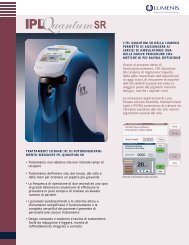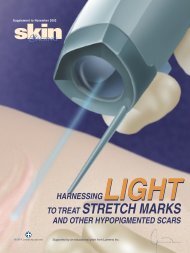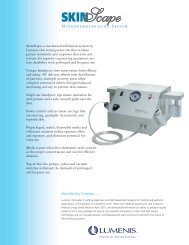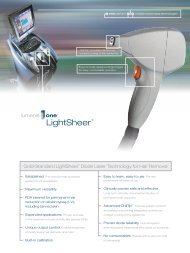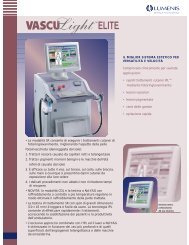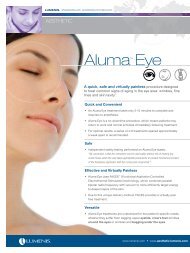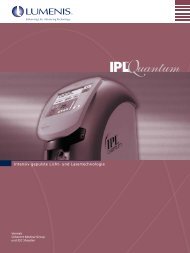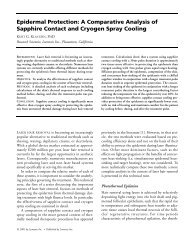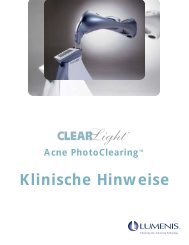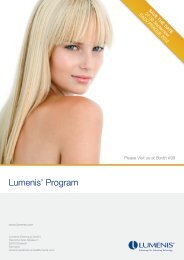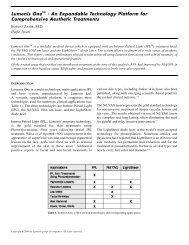Clinical Trials Confirm LightSheer Duet as Game Changer in Hair ...
Clinical Trials Confirm LightSheer Duet as Game Changer in Hair ...
Clinical Trials Confirm LightSheer Duet as Game Changer in Hair ...
You also want an ePaper? Increase the reach of your titles
YUMPU automatically turns print PDFs into web optimized ePapers that Google loves.
THE<br />
CLINICAL ROUNDTABLE SUPPLEMENT<br />
®<br />
<strong>Cl<strong>in</strong>ical</strong> <strong>Trials</strong> <strong>Confirm</strong> <strong>LightSheer</strong> <strong>Duet</strong> <strong>as</strong> <strong>Game</strong> <strong>Changer</strong> <strong>in</strong> <strong>Hair</strong> Removal<br />
By Kev<strong>in</strong> A. Wilson, Contribut<strong>in</strong>g Editor<br />
Lumenis, Ltd. (Yokneam, Israel) re<strong>as</strong>serted its leadership<br />
<strong>in</strong> the aesthetic market with the rele<strong>as</strong>e of<br />
the versatile <strong>LightSheer</strong> <strong>Duet</strong> platform for l<strong>as</strong>er hair<br />
removal. Featur<strong>in</strong>g two handpieces, the smaller<br />
spot size ET delivers higher fluences with contact<br />
cool<strong>in</strong>g and the larger spot size HS (high speed)<br />
provides lower fluences with vacuum-<strong>as</strong>sist. The<br />
ability to perform s<strong>in</strong>gle p<strong>as</strong>s treatments and no<br />
need for external cool<strong>in</strong>g make l<strong>as</strong>er hair removal<br />
with <strong>LightSheer</strong> <strong>Duet</strong> e<strong>as</strong>ier on cl<strong>in</strong>icians, <strong>as</strong><br />
well <strong>as</strong> patients. Furthermore, the HS handpiece’s<br />
safety, efficacy and treatment speed have been<br />
supported by recent cl<strong>in</strong>ical trials.<br />
May/June 2011<br />
Medical Insight, Inc. ® • 120 Vantis #470, Aliso Viejo, CA 92656 • (949) 830-5409 • Facsimile: (949) 830-8944 • www.mi<strong>in</strong>ews.com
cl<strong>in</strong>ical roundtable | <strong>LightSheer</strong> <strong>Duet</strong><br />
“The fact that new technologies often choose <strong>LightSheer</strong><br />
<strong>as</strong> the b<strong>as</strong>is for comparison emph<strong>as</strong>izes that it’s such a<br />
trusted and popular device.”<br />
Built around the popular and effective 800<br />
Shlomit Halachmi, M.D., Ph.D.<br />
nm diode l<strong>as</strong>er, the orig<strong>in</strong>al <strong>LightSheer</strong> h<strong>as</strong> arguably<br />
been the gold standard <strong>in</strong> l<strong>as</strong>er hair<br />
Rab<strong>in</strong> Medical Center<br />
Dermatologist<br />
removal, noted dermatologist Shlomit Halachmi,<br />
Petach Tikva, Israel<br />
M.D., Ph.D., of the Rab<strong>in</strong> Medical Center<br />
(Petach Tikva, Israel). “The fact that new technologies<br />
often choose <strong>LightSheer</strong> <strong>as</strong> the b<strong>as</strong>is<br />
for comparison emph<strong>as</strong>izes that it’s such a trusted and popular device.”<br />
<strong>Hair</strong> follicle treated with sapphirecooled<br />
(ET) handpiece show<strong>in</strong>g<br />
significant thermal damage<br />
<strong>Hair</strong> follicle treated with vacuum<strong>as</strong>sisted<br />
(HS) handpiece, show<strong>in</strong>g<br />
significant thermal damage<br />
Photos courtesy of E. Victor Ross, M.D.<br />
E. Victor Ross, M.D.<br />
Dermatologist<br />
Director<br />
L<strong>as</strong>er and Cosmetic Dermatology Unit<br />
Scripps Cl<strong>in</strong>ic<br />
San Diego, CA<br />
The platform itself, accord<strong>in</strong>g to E. Victor<br />
Ross, M.D., director of the l<strong>as</strong>er and cosmetic<br />
dermatology unit at Scripps Cl<strong>in</strong>ic <strong>in</strong> San Diego,<br />
Calif., h<strong>as</strong> always been very user-friendly. “The<br />
<strong>in</strong>terface is very <strong>in</strong>tuitive and the device guides<br />
you through treatment, so the learn<strong>in</strong>g curve is<br />
very shallow.” <strong>LightSheer</strong> <strong>Duet</strong> also runs on a standard power outlet for h<strong>as</strong>sle-free <strong>in</strong>stallation<br />
and use.<br />
“Harness<strong>in</strong>g the pr<strong>in</strong>ciple of selective photothermolysis for hair removal is very effective,”<br />
Dr. Halachmi stated, “but it can be somewhat difficult for patients to tolerate due<br />
to long treatment times, and some discomfort. There is also an <strong>in</strong>herent risk <strong>in</strong> some<br />
treatments because higher fluences translate <strong>in</strong>to greater discomfort and an <strong>in</strong>cre<strong>as</strong>ed<br />
risk of adverse events. L<strong>as</strong>er manufacturers have begun to address this problem by<br />
develop<strong>in</strong>g creative technologies that deliver the l<strong>as</strong>er energy <strong>in</strong> different ways, so that<br />
the hair follicle absorbs a therapeutic level of energy but the temperature of the epidermis<br />
rema<strong>in</strong>s low and safe.”<br />
While the <strong>LightSheer</strong> <strong>Duet</strong> ET handpiece provides the traditional l<strong>as</strong>er hair removal<br />
modality <strong>in</strong> a small 9 mm x 9 mm spot size, with higher fluences (10 – 100 J/cm 2 ), the<br />
HS handpiece offers lower fluences (4.5 to 12 J/cm 2 ), but a much larger 22 mm x 35<br />
mm spot size which is the largest of any currently-available hair removal diode l<strong>as</strong>er.<br />
This makes hair removal with <strong>LightSheer</strong> <strong>Duet</strong> a f<strong>as</strong>ter, more comfortable procedure,<br />
which is more attractive to patients. “This significantly larger spot, among other th<strong>in</strong>gs,<br />
is what makes the HS handpiece stand out,” said Dr. Ross. “This translates <strong>in</strong>to a reduction<br />
<strong>in</strong> treatment time of up to 75%, which h<strong>as</strong> numerous, obvious benefits <strong>as</strong> long<br />
<strong>as</strong> the safety and efficacy are there.”<br />
Dr. Halachmi also po<strong>in</strong>ted out that the vacuum-<strong>as</strong>sist technology <strong>in</strong>corporated <strong>in</strong>to<br />
the HS handpiece br<strong>in</strong>gs with it additional benefits, led by one <strong>in</strong> particular: “by <strong>in</strong>duc<strong>in</strong>g<br />
pressure at the periphery of the treatment area at each pulse, pa<strong>in</strong> is further reduced<br />
via neural gat<strong>in</strong>g. This makes treatment even more comfortable.”<br />
In addition to l<strong>as</strong>er hair removal, <strong>LightSheer</strong> <strong>Duet</strong> ET is also FDA cleared for the treatment<br />
of benign v<strong>as</strong>cular lesions and leg ve<strong>in</strong>s, pseudofolliculitis barbae (PFB) and benign<br />
pigmented lesions.<br />
Editor’s Note: In the follow<strong>in</strong>g cl<strong>in</strong>ical roundtable, five dermatologists share their<br />
knowledge, cl<strong>in</strong>ical expertise and experience with <strong>LightSheer</strong> <strong>Duet</strong> ET and HS. Collectively<br />
they br<strong>in</strong>g decades of cl<strong>in</strong>ical and research experience with l<strong>as</strong>er hair removal.<br />
2 THE Aesthetic Guide May/June 2011 www.mi<strong>in</strong>ews.com
cl<strong>in</strong>ical roundtable | <strong>LightSheer</strong> <strong>Duet</strong><br />
“There are three major characteristics differentiat<strong>in</strong>g the HS<br />
handpiece from everyth<strong>in</strong>g else. The first is the spot size.<br />
Second is the vacuum-<strong>as</strong>sist. Thirdly, the gold plat<strong>in</strong>g <strong>in</strong>side<br />
the handpiece <strong>in</strong>cre<strong>as</strong>es the efficiency of energy delivery.”<br />
What dist<strong>in</strong>guishes the new HS handpiece from the ET handpiece, and compet<strong>in</strong>g<br />
technologies <strong>in</strong> general? What do you th<strong>in</strong>k is the most significant benefit, and why?<br />
Dr. Ross – There are three major characteristics differentiat<strong>in</strong>g the HS handpiece from<br />
everyth<strong>in</strong>g else. The first is the spot size, which is significantly larger. This allows for a<br />
much f<strong>as</strong>ter treatment. Second is the vacuum-<strong>as</strong>sist, which draws tissue up <strong>in</strong>to the treatment<br />
tip before the l<strong>as</strong>er is fired. This theoretically reduces the concentration of compet<strong>in</strong>g<br />
chromophores such <strong>as</strong> epidermal melan<strong>in</strong> and hemoglob<strong>in</strong>, but also reduces treatment<br />
pa<strong>in</strong>, so there’s no need for topical anesthetic or epidermal cool<strong>in</strong>g. Thirdly, the<br />
gold plat<strong>in</strong>g <strong>in</strong>side the handpiece <strong>in</strong>cre<strong>as</strong>es the efficiency of energy delivery.<br />
Omar A. Ibrahimi, M.D., Ph.D. – The limitations<br />
of currently available hair removal devices <strong>in</strong>clude<br />
small treatment spot size, treatment-<strong>as</strong>sociated<br />
pa<strong>in</strong>, and the need for epidermal cool<strong>in</strong>g.<br />
In my op<strong>in</strong>ion, the HS handpiece is a game<br />
changer <strong>in</strong> l<strong>as</strong>er hair removal treatments for a<br />
few re<strong>as</strong>ons. It h<strong>as</strong> the largest spot size of any<br />
commercially available hair removal l<strong>as</strong>er so treatments of larger body are<strong>as</strong>, such <strong>as</strong><br />
the back or legs, can be performed more rapidly, which may lead to improved affordability.<br />
Also, the science beh<strong>in</strong>d the HS handpiece allows for successful treatment at a<br />
lower fluence, thereby conferr<strong>in</strong>g hair removal efficacy similar to that of other l<strong>as</strong>ers, but<br />
with much lower levels of discomfort dur<strong>in</strong>g treatment.<br />
Girish Munavalli, M.D., M.H.S.,<br />
F.A.A.D.<br />
Dermatologist<br />
Dermatology, L<strong>as</strong>er & Ve<strong>in</strong> Specialists<br />
of the Carol<strong>in</strong><strong>as</strong><br />
Charlotte, NC<br />
Omar A. Ibrahimi, M.D., Ph.D.<br />
Director of L<strong>as</strong>er and Cosmetics<br />
UConn Dermatology<br />
Visit<strong>in</strong>g Scientist<br />
Wellman Laboratories, Harvard<br />
Medical School<br />
Farm<strong>in</strong>gton, CT and Boston, MA<br />
Girish Munavalli, M.D. – The spot size of the HS handpiece and subsequent <strong>in</strong>cre<strong>as</strong>e<br />
<strong>in</strong> treatment speed make it ideal for the larger are<strong>as</strong> of the body like the back or legs.<br />
These are<strong>as</strong> take forever with smaller handpieces, but with the HS it takes practically<br />
no time at all. Plus, the fluence is so low and it’s so well tolerated that you don’t need<br />
topical anesthesia or similar pre-treatment protocols<br />
which would <strong>in</strong>cre<strong>as</strong>e the overall treatment<br />
time. The ET is still great for smaller are<strong>as</strong><br />
such <strong>as</strong> the ch<strong>in</strong>; it’s perfectly f<strong>in</strong>e with the active<br />
sapphire cool<strong>in</strong>g, and the pulse width is<br />
adjustable so you can modulate the energy<br />
delivery <strong>as</strong> well, mak<strong>in</strong>g the platform very versatile.<br />
You can e<strong>as</strong>ily switch between the two handpieces, simply by putt<strong>in</strong>g one back<br />
and tak<strong>in</strong>g the other one out. The device knows which one you’re us<strong>in</strong>g and changes<br />
the user <strong>in</strong>terface automatically, so the time it takes to switch is m<strong>in</strong>imal.<br />
<strong>LightSheer</strong> <strong>Duet</strong> ET handpiece<br />
<strong>LightSheer</strong> <strong>Duet</strong> HS handpiece<br />
Photos courtesy of E. Victor Ross, M.D.<br />
Dr. Halachmi – Although traditional l<strong>as</strong>er hair removal is effective and generally well<br />
tolerated, there are three <strong>as</strong>pects which can be improved: treatment speed, discomfort<br />
and risk of adverse events. The large spot size of the HS handpiece h<strong>as</strong> significant<br />
advantages <strong>in</strong> all three are<strong>as</strong>. First and most simply, you can cover more area more<br />
quickly with a larger spot size. Secondly, the larger spot size allows better penetration<br />
of the l<strong>as</strong>er energy – mean<strong>in</strong>g that less energy needs to be applied at the surface to<br />
achieve therapeutic heat<strong>in</strong>g at the depth of the hair follicles. Lower fluence at the epidermis<br />
translates <strong>in</strong>to less pa<strong>in</strong> and lower risk of adverse events.<br />
THE Aesthetic Guide May/June 2011 www.mi<strong>in</strong>ews.com<br />
3
cl<strong>in</strong>ical roundtable | <strong>LightSheer</strong> <strong>Duet</strong><br />
“The 800 nm diode l<strong>as</strong>er is well-absorbed by melan<strong>in</strong>,<br />
and it will penetrate to the hair bulb, but the epidermis<br />
is still largely spared; those qualities are essential to<br />
effective hair removal treatment.”<br />
Are there other devices that use the same b<strong>as</strong>ic reduced-fluence pr<strong>in</strong>ciple?<br />
Cauc<strong>as</strong>ian, sk<strong>in</strong> type: IV, brown hair<br />
Fluence: 11 J/cm 2<br />
Pulse time: 50 – 100 ms<br />
Vacuum: Medium<br />
Dr. Halachmi – For reduced discomfort, one compet<strong>in</strong>g device is designed to heat the<br />
deep follicles effectively while reduc<strong>in</strong>g epidermal heat<strong>in</strong>g, but it does so from a different<br />
approach. The handpiece is moved repeatedly and quickly over the treatment area<br />
to allow slow heat build-up <strong>in</strong> the follicles, while the epidermis cools between the repeated<br />
p<strong>as</strong>ses. For improved treatment speed, a different device scans l<strong>as</strong>er light over<br />
a large area. In comparison, the HS handpiece addresses both treatment speed and<br />
comfort for patients and cl<strong>in</strong>icians with its larger spot and vacuum-<strong>as</strong>sist technology.<br />
What is the benefit of hav<strong>in</strong>g the ET handpiece on the device <strong>as</strong> well?<br />
Dr. Halachmi – Certa<strong>in</strong> are<strong>as</strong> will require a small tip, while others are suitable for the<br />
larger spot, so it’s convenient to have both the small spot ET and the large spot HS<br />
handpieces attached to the same platform. We switch on the fly between the large and<br />
the small tips, simply by lift<strong>in</strong>g one or the other from its holster when needed.<br />
Axilla before Tx, b<strong>as</strong>el<strong>in</strong>e<br />
What determ<strong>in</strong>es whether you choose the ET or HS handpiece for treatment?<br />
Suzanne L. Kilmer, M.D. – For a larger area, or<br />
one that’s more sensitive and large enough to<br />
accommodate the spot size, the HS handpiece<br />
would be the way to go because of the speed<br />
and relative comfort. The ET handpiece would<br />
be better for smaller or curved are<strong>as</strong> where the<br />
HS handpiece is not suitable for use.<br />
Suzanne L. Kilmer, M.D.<br />
Dermatologist<br />
The Sk<strong>in</strong> Surgery Center of Northern<br />
California<br />
Sacramento, CA<br />
What is the function of the gold plat<strong>in</strong>g <strong>in</strong>side the HS handpiece?<br />
Axilla six months after three<br />
<strong>LightSheer</strong> <strong>Duet</strong> HS treatments<br />
Dr. Ross – Dur<strong>in</strong>g l<strong>as</strong>er hair removal with an 800 nm diode l<strong>as</strong>er, 50% to 60% of the<br />
energy is simply remitted off the sk<strong>in</strong>. The gold plat<strong>in</strong>g <strong>in</strong>side the vacuum tip reflects<br />
many remitted photons back to the sk<strong>in</strong>, optimiz<strong>in</strong>g the use of the energies employed<br />
for low-fluence hair reduction.<br />
Is there any special quality to the 800 nm wavelength that makes it ideal for hair<br />
reduction?<br />
Axilla 15 months after three<br />
<strong>LightSheer</strong> <strong>Duet</strong> HS treatments<br />
Photos courtesy of Suzanne L. Kilmer, M.D.<br />
Dr. Kilmer – The 800 nm diode l<strong>as</strong>er h<strong>as</strong> a relatively established history of efficacy for<br />
long-term hair reduction. As a community we have so much experience with this wavelength<br />
that there are relatively few unknowns at this po<strong>in</strong>t. The wavelength is well-absorbed<br />
by melan<strong>in</strong>, and it will penetrate to the hair bulb, but the epidermis is still<br />
largely spared; those qualities are essential to effective hair removal treatment.<br />
What are the benefits of vacuum-<strong>as</strong>sist technology?<br />
Dr. Halachmi – There is a recession <strong>in</strong> the tip, <strong>in</strong>to which the sk<strong>in</strong> is drawn by vacuum.<br />
This theoretically and temporarily reduces the density of compet<strong>in</strong>g melan<strong>in</strong> and hemoglob<strong>in</strong>,<br />
which theoretically reduces the loss of l<strong>as</strong>er energy to compet<strong>in</strong>g chromophores,<br />
but the benefit of that is m<strong>in</strong>imal compared to what the larger spot size does to facilitate<br />
e<strong>as</strong>e of treatment. The best benefit of the vacuum-<strong>as</strong>sist technology is the reduction of<br />
4 THE Aesthetic Guide May/June 2011 www.mi<strong>in</strong>ews.com
cl<strong>in</strong>ical roundtable | <strong>LightSheer</strong> <strong>Duet</strong><br />
“If patients come <strong>in</strong> and struggle to tolerate treatment after<br />
a few tries, you simply won’t see them aga<strong>in</strong>. With the HS<br />
handpiece this issue is all but elim<strong>in</strong>ated because treatment<br />
discomfort and treatment time are dramatically reduced.”<br />
pa<strong>in</strong> by the neural gate theory; the suction sensation triggers the large sensory nerve fibers<br />
before the application of energy which <strong>in</strong>hibits the transmission of pa<strong>in</strong> signals to<br />
the bra<strong>in</strong>. The patient feels the vacuum pressure rather than the l<strong>as</strong>er pulse.<br />
What is the role of compliance <strong>in</strong> hair removal treatment? How does <strong>LightSheer</strong> <strong>Duet</strong><br />
help improve compliance?<br />
Dr. Ibrahimi – Compliance is critical to achiev<strong>in</strong>g long-term hair reduction with any<br />
l<strong>as</strong>er treatment. Even the best hair removal l<strong>as</strong>ers require a series of five to ten treatments<br />
or more for near-total hair reduction. Often patients will also need occ<strong>as</strong>ional<br />
ma<strong>in</strong>tenance treatments thereafter. The vacuum-<strong>as</strong>sist technology and larger spot size<br />
of the HS handpiece facilitate energy delivery allow<strong>in</strong>g for lower levels of treatment<br />
discomfort. This makes it much e<strong>as</strong>ier for patients to tolerate treatment, <strong>in</strong> comparison<br />
to other hair removal l<strong>as</strong>ers, so patients are more will<strong>in</strong>g to adhere to a full treatment<br />
course and thus achieve the desired cl<strong>in</strong>ical outcomes.<br />
Dr. Munavalli – It’s accepted that patients will need quite a few treatments to achieve the<br />
clearance they expect, and that hair removal treatment is uncomfortable. If patients come<br />
<strong>in</strong> and struggle to tolerate treatment after a few tries, you simply won’t see them aga<strong>in</strong>, and<br />
they will undoubtedly be unhappy with the experience. This is understandable, but we<br />
want to avoid this if at all possible because our success rides on patient satisfaction and<br />
confidence <strong>in</strong> us. With the HS handpiece this issue is all but elim<strong>in</strong>ated because treatment<br />
discomfort and treatment time are dramatically reduced. If it doesn’t take too long and<br />
doesn’t hurt much, patients are much more likely to get what they came for.<br />
Asian, sk<strong>in</strong> type: III, brown hair<br />
Fluence: 11 J/cm 2<br />
60 ms<br />
Vacuum: Medium<br />
Axilla before Tx, b<strong>as</strong>el<strong>in</strong>e<br />
Ple<strong>as</strong>e describe your recent cl<strong>in</strong>ical trials with the HS handpiece.<br />
Dr. Halachmi – We conducted a side-by-side comparison study of the <strong>LightSheer</strong> <strong>Duet</strong><br />
HS handpiece versus the traditional ET handpiece for axillary hair removal <strong>in</strong> 14<br />
healthy women aged 18 to 59. Once per month, all participants underwent ET treatments<br />
on one side and HS on the other, us<strong>in</strong>g parameters that were matched to their<br />
sk<strong>in</strong> type and hair. We performed a course of five treatments <strong>in</strong> this pilot study. Followup<br />
w<strong>as</strong> conducted one and three months after the fifth treatment. Evaluations were<br />
conducted by photography, <strong>as</strong> well <strong>as</strong> participant feedback. Of the 14 participants,<br />
11 completed the study; three left for re<strong>as</strong>ons unrelated to treatment. All 11 subjects<br />
who completed the study experienced comparable hair reduction on both sides. When<br />
we compared the ET and HS sides after five treatments and three months follow-up, we<br />
saw no discernable difference between the ET and HS treated sites.<br />
We saw significant hair reduction after five treatments. For complete hair reduction<br />
<strong>in</strong> the axilla, about twice the numbers of treatments is needed <strong>in</strong> my experience. The<br />
study participants were offered to cont<strong>in</strong>ue the treatments outside of the study, at their<br />
own cost. N<strong>in</strong>e of the eleven <strong>in</strong>dicated that they would like to cont<strong>in</strong>ue treatment us<strong>in</strong>g<br />
the HS handpiece.<br />
Dr. Munavalli – We did a remarkably similar <strong>in</strong>formal trial <strong>in</strong>dependent of Dr.<br />
Halachmi’s study, treat<strong>in</strong>g eight patients, us<strong>in</strong>g each handpiece on both sides – but not<br />
limit<strong>in</strong>g ourselves to just one area – and compared efficacy. We had some long-term<br />
follow-up of up to n<strong>in</strong>e months after five treatments. What we b<strong>as</strong>ically found w<strong>as</strong> that<br />
Axilla six months after three<br />
<strong>LightSheer</strong> <strong>Duet</strong> HS treatments<br />
Axilla 15 months after three<br />
<strong>LightSheer</strong> <strong>Duet</strong> HS treatments<br />
Photos courtesy of Suzanne L. Kilmer, M.D.<br />
THE Aesthetic Guide May/June 2011 www.mi<strong>in</strong>ews.com<br />
5
cl<strong>in</strong>ical roundtable | <strong>LightSheer</strong> <strong>Duet</strong><br />
“Compared to other commercially available long-pulsed<br />
diode devices, treatments may be f<strong>as</strong>ter to perform and<br />
less likely to be pa<strong>in</strong>ful.”<br />
efficacy between the ET and HS handpieces w<strong>as</strong> very similar, but <strong>in</strong> terms of treatment<br />
speed and comfort, the HS handpiece w<strong>as</strong> dramatically superior. This suggests that the<br />
HS handpiece h<strong>as</strong> tremendous potential for success <strong>in</strong> the hair removal arena.<br />
Cauc<strong>as</strong>ion, sk<strong>in</strong> type IV, brown hair<br />
Fluence: 9 – 10 J/cm 2<br />
Pulse time: 47 – 100 ms<br />
Vacuum: Medium<br />
Axilla before Tx, b<strong>as</strong>el<strong>in</strong>e<br />
Dr. Ibrahimi – In the prospective study we conducted, which is currently under peer-review<br />
for future publication, we sought to evaluate the long-term hair reduction capabilities of the<br />
<strong>LightSheer</strong> <strong>Duet</strong> HS handpiece. We enrolled 35 subjects (all women, predom<strong>in</strong>antly<br />
Cauc<strong>as</strong>ian with some Asian and Hispanic, sk<strong>in</strong> types II to IV) and treated their axillae with<br />
the HS handpiece for three treatments at <strong>in</strong>tervals of four to six weeks, with follow-up visits<br />
at six and 15 months after the l<strong>as</strong>t treatment. Clearance w<strong>as</strong> quantified us<strong>in</strong>g hair counts,<br />
with <strong>as</strong>sessments performed by three different physicians <strong>in</strong>dependently, us<strong>in</strong>g photographs<br />
taken at b<strong>as</strong>el<strong>in</strong>e, at six month follow-up, and at 15 month follow-up.<br />
Evaluation of the results showed statistically significant hair clearance, 54% and 42%<br />
at 6 and 15 month follow-up visits, respectively. For rema<strong>in</strong><strong>in</strong>g hair, there w<strong>as</strong> a mean<br />
decre<strong>as</strong>e <strong>in</strong> thickness of 19% and a mean lighten<strong>in</strong>g of color by 10% at the 15 month<br />
follow-up visit compared to b<strong>as</strong>el<strong>in</strong>e. The majority of subjects reported feel<strong>in</strong>g no more<br />
than mild-to-moderate pa<strong>in</strong> dur<strong>in</strong>g treatment without the use of pre-treatment anesthesia<br />
or sk<strong>in</strong> cool<strong>in</strong>g. Note that these numbers are after three treatments, and <strong>in</strong> a normal<br />
course one might perform five to ten treatments.<br />
From the results we concluded that the <strong>LightSheer</strong> <strong>Duet</strong> HS handpiece is safe and<br />
effective for long-term hair removal. Compared to other commercially available longpulsed<br />
diode devices, treatments may be f<strong>as</strong>ter to perform and less likely to be pa<strong>in</strong>ful.<br />
This is the largest prospective study to evaluate long-term hair removal and the first to<br />
quantify decre<strong>as</strong>es <strong>in</strong> hair thickness and darkness with treatment.<br />
Axilla six months after three<br />
<strong>LightSheer</strong> <strong>Duet</strong> HS treatments<br />
Axilla 15 months after three<br />
<strong>LightSheer</strong> <strong>Duet</strong> HS treatments<br />
Photos courtesy of Suzanne L. Kilmer, M.D.<br />
Dr. Kilmer – Another po<strong>in</strong>t Dr. Ibrahimi and I would like to make about our study is that the<br />
hair count data, good <strong>as</strong> it is, understates the impact of the actual cl<strong>in</strong>ical result. While the<br />
more objective evaluation criteria of the study <strong>in</strong>volved hard counts of <strong>in</strong>dividual hairs before<br />
and after the course of treatment, the true cl<strong>in</strong>ical outcome <strong>in</strong>cludes th<strong>in</strong>n<strong>in</strong>g and<br />
lighten<strong>in</strong>g of hair <strong>in</strong> the treatment area, which is admittedly more subjective but might better<br />
represent what one actually sees. When count<strong>in</strong>g hairs, every one counts, whether it’s<br />
f<strong>in</strong>e and light or not. Even so, the hair count data for the study w<strong>as</strong> very strong.<br />
Dr. Ross – In our study 1 , we treated five patients (male, sk<strong>in</strong> types I to IV with relatively<br />
thick black hair) with three s<strong>in</strong>gle pulse test spots on the right back with the lower fluence<br />
HS handpiece (10 – 12 J/cm 2 , 61 ms pulse duration), and three s<strong>in</strong>gle-pulse test spots<br />
on the left back with the higher fluence ET handpiece (30 – 34 J/cm 2 , 14 – 16 ms pulse<br />
duration). Parameters with the ET handpiece were determ<strong>in</strong>ed by patient pa<strong>in</strong> tolerance<br />
and epidermal tolerance; this w<strong>as</strong>n’t an issue with the HS handpiece. After treatment,<br />
punch biopsies were performed on each treatment area, sectioned transversely, <strong>as</strong> well<br />
<strong>as</strong> horizontally, and exam<strong>in</strong>ed for thermal damage to the hair follicle. We chose to do<br />
this on males because the back is the area large enough to e<strong>as</strong>ily accommodate our test,<br />
and because any scarr<strong>in</strong>g from the punch biopsies would be less conspicuous.<br />
We saw thermal damage <strong>in</strong> all sites tested. Overall, thermal damage with the ET<br />
handpiece w<strong>as</strong> more severe, maybe 20% to 30% greater versus the HS handpiece.<br />
That makes sense because we used three times the fluence, but it’s notable that we<br />
6 THE Aesthetic Guide May/June 2011 www.mi<strong>in</strong>ews.com
cl<strong>in</strong>ical roundtable | <strong>LightSheer</strong> <strong>Duet</strong><br />
“From a personal perspective, <strong>as</strong> a dermatologist and a<br />
person with sk<strong>in</strong> of color, I’d like to see further study us<strong>in</strong>g the<br />
<strong>LightSheer</strong> <strong>Duet</strong> HS handpiece for darker sk<strong>in</strong> types so that<br />
we might better establish and then optimize parameters.”<br />
didn’t see three times the difference <strong>in</strong> damage. It didn’t scale <strong>as</strong> one might th<strong>in</strong>k at<br />
first, not even close. The actual difference <strong>in</strong> thermal damage w<strong>as</strong> fairly subtle.<br />
This study showed that even with relatively low fluence, one can achieve thermal<br />
damage sufficient enough to damage the follicle, possibly permanently. Specific to the<br />
HS handpiece, when you take the fluence alone and ignore the remitted-then-reflected<br />
photons (gold plat<strong>in</strong>g), large spot size and vacuum-<strong>as</strong>sist, <strong>in</strong>tuitively one would conclude<br />
that there shouldn’t be much therapeutic effect on hair follicles. Upon study, we<br />
believe it’s fair to conclude that these elements appear to contribute to the <strong>in</strong>cre<strong>as</strong>ed<br />
thermal damage seen.<br />
Ideally, where would you like to go next with cl<strong>in</strong>ical study of <strong>LightSheer</strong> <strong>Duet</strong>?<br />
Dr. Ross – It would be great to see a nice, large, side-by-side study between the low<br />
fluence larger spot and the high fluence smaller spot, followed at 3, 6, 12 and 18<br />
months out with hair counts. This would be an expensive and time consum<strong>in</strong>g undertak<strong>in</strong>g,<br />
which is why we probably won’t see it. The time and expense that comes with hair<br />
removal studies are common prohibitive factors. You need to do so many treatments,<br />
and patients – <strong>as</strong> well <strong>as</strong> the staff and physicians <strong>in</strong>volved – must be will<strong>in</strong>g to go<br />
through this. Most physicians and companies aren’t will<strong>in</strong>g to do that for hair removal;<br />
maybe for a heart dise<strong>as</strong>e or cancer study, but not someth<strong>in</strong>g like hair removal.<br />
Lower abdomen before Tx, b<strong>as</strong>el<strong>in</strong>e<br />
Dr. Ibrahimi – In theory, the various features of the HS handpiece might make it better<br />
able to treat darker sk<strong>in</strong> types. From a personal perspective, <strong>as</strong> a dermatologist and a<br />
person with sk<strong>in</strong> of color, I’d like to see further study us<strong>in</strong>g the <strong>LightSheer</strong> <strong>Duet</strong> HS<br />
handpiece for darker sk<strong>in</strong> types so that we might better establish and then optimize<br />
parameters.<br />
Do the features of the HS handpiece make it more suitable for treat<strong>in</strong>g darker sk<strong>in</strong><br />
types?<br />
Dr. Munavalli – The vacuum-<strong>as</strong>sist technology with the HS handpiece artificially reduces<br />
the melan<strong>in</strong> concentration of the sk<strong>in</strong> without affect<strong>in</strong>g the hairs themselves, so<br />
theoretically this may improve treatment, but it’s difficult to p<strong>in</strong> that down. We have<br />
treated many darker sk<strong>in</strong>ned patients and they respond fairly well. You do have to be<br />
careful. There are tricks you can do like pre-cool<strong>in</strong>g the sk<strong>in</strong>. When consider<strong>in</strong>g patients<br />
with sk<strong>in</strong> of color, the quality of the hair is a key factor <strong>in</strong> decision mak<strong>in</strong>g. It’s<br />
important that patients with darker sk<strong>in</strong> tones, who want to undergo l<strong>as</strong>er hair removal,<br />
have dark, coarse hair at the treatment site.<br />
Lower abdomen six months after<br />
five <strong>LightSheer</strong> <strong>Duet</strong> HS treatments<br />
Photos courtesy of Girish Munavalli, M.D.,<br />
M.H.S., F.A.A.D.<br />
Do the features of the HS handpiece make it more suitable for treat<strong>in</strong>g men?<br />
Dr. Halachmi – The HS handpiece is excellent for men because it can cover a large<br />
area, like the back or chest, very quickly. We are cautious about choos<strong>in</strong>g male candidates<br />
for chest and back treatment. Good candidates are those who have very dark<br />
and very coarse hair. Men with f<strong>in</strong>e hair or light hair will not respond well to any l<strong>as</strong>er<br />
hair removal treatment.<br />
THE Aesthetic Guide May/June 2011 www.mi<strong>in</strong>ews.com<br />
7
cl<strong>in</strong>ical roundtable | <strong>LightSheer</strong> <strong>Duet</strong><br />
“The safety of this device is well established. <strong>LightSheer</strong> h<strong>as</strong><br />
been around for so long, and the 800 nm wavelength is<br />
well known and h<strong>as</strong> been thoroughly studied. It’s pretty much<br />
the gold standard for l<strong>as</strong>er hair removal. Current studies are<br />
offer<strong>in</strong>g strong evidence that the new HS handpiece is a<br />
significant improvement over its predecessors.”<br />
What are the bus<strong>in</strong>ess advantages of a f<strong>as</strong>ter, more comfortable treatment if safety<br />
and efficacy are equal?<br />
Dr. Munavalli – The obvious benefit is the speed allow<strong>in</strong>g you to successfully treat more<br />
patients <strong>in</strong> less time, with reduced pa<strong>in</strong> <strong>in</strong>cre<strong>as</strong><strong>in</strong>g compliance, <strong>as</strong> well <strong>as</strong> the likelihood<br />
that patients will undergo the entire course of therapy and be satisfied with their<br />
results. If your competition cannot offer this then you have a competitive advantage,<br />
because patients historically want the best results with the le<strong>as</strong>t discomfort and<br />
h<strong>as</strong>sle.<br />
Axilla before Tx, b<strong>as</strong>el<strong>in</strong>e<br />
Dr. Halachmi – The major advantage is the reduced treatment time. This allows schedul<strong>in</strong>g<br />
of more procedures <strong>in</strong> the same work hours, which <strong>in</strong>cre<strong>as</strong>es revenue potential.<br />
An additional benefit is that no topical anesthetic is needed and no cool<strong>in</strong>g gel need<br />
be applied to the treatment area, further reduc<strong>in</strong>g prep time and <strong>in</strong>cre<strong>as</strong><strong>in</strong>g the efficiency<br />
of the schedul<strong>in</strong>g.<br />
Dr. Ross – The HS handpiece is also e<strong>as</strong>ier on the user. The larger spot treats more<br />
rapidly <strong>in</strong> a s<strong>in</strong>gle p<strong>as</strong>s, and when you have larger are<strong>as</strong> you just want to cover a lot<br />
of ground f<strong>as</strong>t. Treatment with older technologies takes longer; the patient gets tired<br />
and so does the cl<strong>in</strong>ician. Over the course of a day it builds up.<br />
Would you like to share any treatment tips or f<strong>in</strong>al thoughts?<br />
Axilla n<strong>in</strong>e months after five<br />
<strong>LightSheer</strong> <strong>Duet</strong> HS treatments<br />
Photos courtesy of Girish Munavalli, M.D.,<br />
M.H.S., F.A.A.D.<br />
Dr. Ibrahimi – The majority of patients <strong>in</strong> my experience prefer the vacuum-<strong>as</strong>sist on the<br />
medium sett<strong>in</strong>g, to help m<strong>in</strong>imize the level of treatment-<strong>as</strong>sociated discomfort. I also<br />
recommend that one always perform a thorough medical history, physical exam and<br />
have an honest discussion of the risks and benefits with any type of l<strong>as</strong>er hair removal<br />
treatment <strong>in</strong> order to educate patients and optimize their experience.<br />
Dr. Munavalli – The safety of this device is well established. <strong>LightSheer</strong> h<strong>as</strong> been around<br />
for so long, and the 800 nm wavelength is well known and h<strong>as</strong> been thoroughly studied.<br />
In terms of efficacy, that’s been proven over the years <strong>as</strong> well. It’s pretty much the gold<br />
standard for l<strong>as</strong>er hair removal. Current studies are offer<strong>in</strong>g strong evidence that the new<br />
HS handpiece is a significant improvement over its predecessors. ■<br />
Reference:<br />
1. Xia Y, Moore M, Cho S, Ross EV. Evaluation of the vacuum-<strong>as</strong>sisted handpiece compared with the<br />
sapphire-cooled handpiece of the 800-nm diode l<strong>as</strong>er system for the use of hair removal and reduction.<br />
J Cosmet L<strong>as</strong>er Ther 2010 Dec; 12(6):264-268.<br />
PB-1103090_A<br />
8 THE Aesthetic Guide May/June 2011 www.mi<strong>in</strong>ews.com



